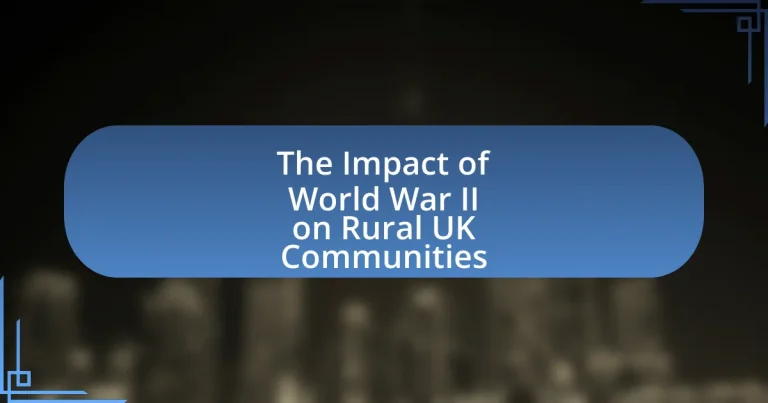The article examines the impact of World War II on rural UK communities, highlighting significant disruptions in demographics, agriculture, and social structures. It details how the war led to labor shortages, prompting the recruitment of women into agriculture and altering traditional gender roles. The influx of urban children due to evacuations, destruction of infrastructure, and the need for post-war rebuilding efforts are also discussed. Additionally, the article explores the long-term effects on community relationships, economic shifts, and cultural changes, emphasizing the legacy of the war in shaping contemporary rural life and the ongoing challenges faced by these communities.

What was the impact of World War II on rural UK communities?
World War II significantly disrupted rural UK communities, leading to changes in demographics, agriculture, and social structures. The war caused a substantial decline in the rural workforce as many men enlisted, resulting in labor shortages on farms. This prompted the government to implement initiatives like the Women’s Land Army, which recruited women to fill these gaps, thereby altering traditional gender roles in agriculture. Additionally, rural areas experienced the evacuation of children from cities, which brought an influx of urban children into these communities, impacting local resources and social dynamics. The war also led to the destruction of infrastructure and homes due to bombings, particularly in areas near military targets, necessitating post-war rebuilding efforts that transformed rural landscapes. These changes collectively reshaped the fabric of rural life in the UK during and after the war.
How did World War II alter the social fabric of rural communities?
World War II significantly altered the social fabric of rural communities by accelerating demographic changes and fostering new social dynamics. The war prompted a migration of workers to rural areas, as industries expanded to support the war effort, leading to increased diversity within these communities. Additionally, the absence of men who went to fight resulted in women taking on roles traditionally held by men, which challenged existing gender norms and contributed to a shift in societal roles. This shift was evidenced by the Women’s Land Army, where women worked in agriculture, thus reshaping perceptions of women’s capabilities and rights. Furthermore, the war fostered a sense of collective identity and solidarity among rural residents, as they banded together to support the war effort through initiatives like food rationing and local production. These changes laid the groundwork for post-war social reforms and a gradual transformation in rural community structures.
What changes occurred in community relationships during the war?
During the war, community relationships in rural UK underwent significant changes characterized by increased collaboration and solidarity among residents. The necessity of collective efforts for war-related activities, such as food production and civil defense, fostered a sense of unity. For instance, the establishment of local committees and volunteer groups, like the Women’s Land Army, exemplified how individuals came together to support the war effort, enhancing social bonds. Additionally, the shared experiences of rationing and the threat of air raids created a communal resilience, as neighbors relied on one another for support and resources. These dynamics transformed previously isolated rural communities into interconnected networks, highlighting the importance of cooperation during challenging times.
How did the war affect gender roles in rural areas?
The war significantly altered gender roles in rural areas by necessitating women’s involvement in agricultural and industrial work as men were conscripted into military service. This shift led to women taking on roles traditionally held by men, such as farm management and machinery operation, which were essential for sustaining food production during wartime. For instance, the Women’s Land Army was established to recruit women to work in agriculture, highlighting the critical need for female labor in rural communities. As a result, women gained new skills and increased independence, challenging pre-war gender norms and laying the groundwork for future changes in societal expectations regarding women’s roles.
What economic impacts did World War II have on rural UK communities?
World War II significantly disrupted rural UK communities economically by altering agricultural production and labor dynamics. The war led to a labor shortage as many men enlisted, resulting in a reliance on women and older individuals to fill roles in farming, which changed traditional labor structures. Additionally, the introduction of wartime policies, such as the Dig for Victory campaign, aimed to increase food production, which required farmers to adapt their practices and invest in new techniques and equipment. This shift often strained resources and altered local economies. Furthermore, the destruction of infrastructure due to bombings in some areas disrupted supply chains and access to markets, impacting rural economies. The government also implemented price controls and rationing, which affected farmers’ income and market dynamics, leading to long-term changes in agricultural practices and rural economic structures post-war.
How did agricultural production change during the war?
Agricultural production in the UK significantly increased during World War II due to heightened demand for food and government initiatives. The war prompted the government to implement policies such as the Dig for Victory campaign, which encouraged citizens to cultivate gardens and utilize all available land for food production. As a result, the area under cultivation expanded, and farmers adopted more intensive farming practices. By 1944, food production had risen by approximately 30% compared to pre-war levels, demonstrating the war’s direct impact on agricultural output.
What were the effects of wartime labor shortages on rural economies?
Wartime labor shortages significantly disrupted rural economies by reducing agricultural productivity and increasing reliance on mechanization. As many rural workers enlisted in the military or migrated to urban areas for war-related jobs, farms faced labor deficits, leading to decreased crop yields and livestock management challenges. For instance, during World War II, the UK saw a decline in agricultural output, with reports indicating a drop of approximately 20% in farm labor availability. This shortage prompted farmers to adopt machinery, which, while initially costly, eventually transformed agricultural practices and increased efficiency in the long term. Additionally, the labor shortages forced rural communities to adapt by forming cooperative farming initiatives, which helped mitigate some economic impacts and fostered community resilience.
What infrastructural changes were brought about by World War II?
World War II led to significant infrastructural changes, particularly in transportation and housing within rural UK communities. The war necessitated the development of new roads and railways to facilitate the movement of troops and supplies, resulting in improved connectivity. Additionally, the post-war period saw a push for the construction of new housing to accommodate returning soldiers and their families, leading to the establishment of new residential areas and the modernization of existing ones. The government implemented policies that prioritized infrastructure development, such as the Town and Country Planning Act of 1947, which aimed to address housing shortages and improve living conditions. These changes not only enhanced the physical landscape but also transformed the social fabric of rural communities, fostering economic growth and accessibility.
How did transportation and communication evolve in rural areas during the war?
Transportation and communication in rural areas evolved significantly during the war due to the necessity of efficient logistics and information dissemination. The introduction of military vehicles and the expansion of road networks improved access to remote areas, facilitating the movement of troops and supplies. Additionally, the establishment of the Rural Post Office and the use of radio communication enhanced connectivity, allowing for quicker dissemination of information and coordination among communities. These changes were driven by the demands of wartime mobilization and the need to support agricultural production, which was crucial for sustaining the war effort.
What role did rural communities play in supporting the war effort?
Rural communities played a crucial role in supporting the war effort during World War II by providing essential resources, manpower, and agricultural production. These communities contributed significantly to food supply through increased agricultural output, which was vital for feeding both military personnel and civilians. For instance, the Ministry of Agriculture and Fisheries reported that rural areas increased food production by 50% during the war, addressing shortages caused by disrupted imports. Additionally, rural residents participated in various volunteer efforts, such as the Women’s Land Army, which mobilized women to work in agriculture, further bolstering food production. This collective effort from rural communities was instrumental in sustaining the war effort and ensuring food security for the nation.

What were the long-term effects of World War II on rural UK communities?
The long-term effects of World War II on rural UK communities included significant demographic changes, economic shifts, and alterations in social structures. Many rural areas experienced depopulation as younger individuals migrated to urban centers for employment opportunities, leading to an aging population in these communities. Economically, the war accelerated the decline of traditional agricultural practices, as mechanization and modernization were introduced, resulting in fewer labor-intensive jobs. Socially, the war fostered a sense of community resilience and solidarity, as rural populations banded together to support each other during and after the conflict. Additionally, government policies post-war, such as the establishment of the National Health Service and housing initiatives, transformed rural living conditions and access to services, further reshaping these communities.
How did post-war policies shape rural development?
Post-war policies significantly shaped rural development by promoting agricultural modernization and infrastructure improvements. The Agricultural Act of 1947, for instance, aimed to increase food production through subsidies and support for farmers, leading to enhanced productivity in rural areas. Additionally, the establishment of the National Health Service in 1948 improved healthcare access in rural communities, contributing to overall rural well-being. These policies collectively transformed rural economies, facilitating a shift from traditional farming practices to more efficient, mechanized methods, which ultimately supported population growth and economic stability in the countryside.
What government initiatives were introduced to support rural recovery?
The government introduced several initiatives to support rural recovery after World War II, including the Agricultural Act of 1947, which aimed to increase food production and stabilize farm incomes. This act provided financial assistance to farmers and encouraged modern farming techniques, contributing to the revitalization of rural economies. Additionally, the Land Settlement Scheme facilitated the resettlement of ex-servicemen and their families on farms, promoting agricultural development and community rebuilding. These initiatives were crucial in addressing the economic challenges faced by rural areas in the aftermath of the war.
How did land use and ownership change after the war?
Land use and ownership in rural UK communities changed significantly after World War II due to government policies and social shifts. The introduction of the Agricultural Act of 1947 aimed to increase food production, leading to the consolidation of smaller farms into larger units for efficiency. This resulted in a shift from traditional farming practices to more industrialized methods, altering land use patterns. Additionally, land ownership became more diversified as returning soldiers and new farmers were encouraged to acquire land, supported by government loans and grants. This transition marked a departure from pre-war land ownership structures, which were often dominated by a few large landowners.
What cultural shifts occurred in rural communities after World War II?
Cultural shifts in rural communities after World War II included increased mobility, changes in gender roles, and the decline of traditional agricultural practices. The war prompted many individuals to seek employment in urban areas, leading to a significant migration from rural to urban settings. This shift resulted in a demographic change, as younger populations left, altering community structures. Additionally, women took on roles traditionally held by men during the war, which contributed to a reevaluation of gender roles in these communities. The introduction of modern farming techniques and machinery also diminished reliance on traditional agricultural methods, leading to a transformation in rural economies and lifestyles. These shifts were documented in various studies, including the “Rural Change in Post-War Britain” report, which highlighted the socio-economic transformations in rural areas during this period.
How did the war influence rural traditions and practices?
The war significantly altered rural traditions and practices in the UK by introducing new labor dynamics and shifting social roles. During World War II, many rural men enlisted in the military, leading to a labor shortage in agriculture. Women stepped into roles traditionally held by men, which not only changed the workforce composition but also challenged gender norms within rural communities. For instance, the Women’s Land Army was established to recruit women for agricultural work, demonstrating a shift in societal expectations and practices. Additionally, wartime rationing and the Dig for Victory campaign encouraged self-sufficiency and communal gardening, which became integral to rural life. These changes reflected a broader adaptation to wartime needs, reshaping long-standing traditions and practices in rural areas.
What role did veterans play in reshaping rural life post-war?
Veterans played a crucial role in reshaping rural life post-war by introducing new agricultural techniques and revitalizing local economies. After World War II, many veterans returned to their rural communities with skills and knowledge gained from military service, which they applied to farming practices. For instance, the adoption of mechanization and modern farming methods increased productivity and efficiency in agriculture. Additionally, veterans often took leadership roles in local organizations, fostering community development and encouraging the establishment of cooperatives. This shift not only improved agricultural output but also stimulated local economies, as veterans reinvested their earnings into their communities, leading to enhanced infrastructure and services.
How can we understand the legacy of World War II in today’s rural UK communities?
The legacy of World War II in today’s rural UK communities is understood through the lasting social, economic, and cultural changes initiated by the war. Socially, the war fostered a sense of community and resilience, as rural populations came together to support the war effort, which is reflected in ongoing community initiatives and local organizations. Economically, the war accelerated agricultural modernization and infrastructure development, leading to increased productivity and changes in land use that continue to shape rural economies. Culturally, the war’s impact is evident in memorials, local histories, and narratives that preserve the memory of those who served, influencing community identity and values. For instance, the establishment of the Land Army during the war has had a lasting influence on women’s roles in agriculture, which is still recognized in contemporary discussions about gender in rural work.
What lessons can be learned from the wartime experiences of rural communities?
Wartime experiences of rural communities during World War II highlight the importance of resilience, community solidarity, and adaptability in the face of adversity. Rural areas often faced resource shortages and the disruption of traditional agricultural practices, which necessitated innovative farming techniques and cooperative efforts among residents. For instance, the Dig for Victory campaign encouraged communities to transform gardens and public spaces into vegetable plots, demonstrating how collective action can address food security challenges. Additionally, the establishment of local support networks, such as the Women’s Land Army, showcased the critical role of women in sustaining agricultural production, emphasizing gender roles’ evolution during crises. These experiences illustrate that rural communities can thrive through collaboration and resourcefulness, lessons that remain relevant in contemporary challenges.
How can current rural policies benefit from historical insights?
Current rural policies can benefit from historical insights by analyzing the socio-economic transformations that occurred in rural UK communities during and after World War II. Historical data reveals that the war prompted significant changes in agricultural practices, labor dynamics, and community organization, which can inform contemporary policy-making. For instance, the wartime necessity for increased food production led to innovations in farming techniques and the establishment of cooperative farming models, which can be adapted to modern sustainability goals. Additionally, understanding the resilience and adaptability of rural communities during this period can guide current policies in fostering community engagement and support systems, ultimately enhancing rural development strategies.
What ongoing challenges do rural communities face that stem from the war?
Rural communities in the UK face ongoing challenges stemming from World War II, including economic decline, population loss, and infrastructure deterioration. The war led to significant disruptions in agricultural production, which has resulted in long-term economic challenges as these communities struggle to recover and adapt to modern agricultural practices. Additionally, many rural areas experienced a demographic shift due to the migration of younger populations to urban centers for better opportunities, leaving behind an aging population that further exacerbates economic stagnation. Infrastructure, such as roads and public services, suffered from neglect during and after the war, leading to difficulties in accessing essential services and hindering economic growth. These factors collectively contribute to the ongoing struggles of rural communities in the UK that are directly linked to the impacts of World War II.
What are the best practices for preserving rural heritage influenced by World War II?
The best practices for preserving rural heritage influenced by World War II include documenting historical narratives, restoring significant structures, and engaging local communities in heritage conservation efforts. Documenting historical narratives involves collecting oral histories and archival materials that reflect the experiences of rural communities during the war, which helps to create a comprehensive understanding of their heritage. Restoring significant structures, such as wartime bunkers or memorials, ensures that tangible links to the past are maintained, allowing future generations to connect with their history. Engaging local communities fosters a sense of ownership and pride in their heritage, encouraging participation in preservation activities and educational programs. These practices are supported by initiatives like the Heritage Lottery Fund, which provides resources for projects aimed at preserving local history and culture.
How can communities engage younger generations in understanding their history?
Communities can engage younger generations in understanding their history by implementing interactive educational programs that focus on local historical events, such as the impact of World War II on rural UK communities. These programs can include workshops, storytelling sessions, and field trips to historical sites, which allow younger individuals to experience history firsthand. For instance, the use of oral histories from local veterans or residents who lived through the war can provide personal insights that resonate more deeply with younger audiences. Research indicates that experiential learning significantly enhances retention and understanding of historical events, making it a powerful tool for community engagement.
What initiatives can be implemented to honor the contributions of rural areas during the war?
Initiatives to honor the contributions of rural areas during the war include establishing memorials, creating educational programs, and organizing community events. Memorials can be erected in rural towns to commemorate local individuals who served or contributed to the war effort, reflecting the sacrifices made by these communities. Educational programs in schools can focus on the historical significance of rural contributions, such as food production and support roles, ensuring that future generations understand their importance. Community events, such as remembrance days or festivals celebrating local history, can foster a sense of pride and recognition for the efforts of rural populations during World War II. These initiatives not only honor the past but also strengthen community bonds and preserve historical narratives.


